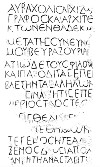Interpretive
Αὐρ[ήλις] Ἀχόλις ἀρχιζω-
γράφος καὶ ἀρχιτέ-
κτων ἐνθάδε κεῖμ[αι]
μετὰ τῆς συνεύνο-
5[υ] μου Βευραζουρία[ς].
ἀξιῶ δὲ τοὺς φίλους
καὶ παροδίτας ἐπι-
βλέψειν τὰς ἀλ[λ]ήλων.
[Π]ρά[ξεις] ἵνα [μή]τις ἐπὶ
10μυριοστὰ ἔτη ὠστ[ι]εῖ[ται]
[μή]τις θελήσ[ει θάπτειν]
μεθ᾿ ἡμῶν
[εἴ]τε γένος εἴτε ἄλ[λος]
ξένος, δώσει ἀπολ[ογ-]
15ίαν ἐν τῇ ἀναστἀσει το[ῦ]
Diplomatic
ΑΥΡ[....]ΑΧΟΛΙΣΑΡΧΙΖΩ
ΓΡΑΦΟΣΚΑΙΑΡΧΙΤΕ
ΚΤΩΝΕΝΘΑΔΕΚΕΙΜ[..]
ΜΕΤΑΤΗΣΣΥΝΕΥΝΟ
5[.]ΜΟΥΒΕΥΡΑΖΟΥΡΙΑ[.]
ΑΞΙΩΔΕΤΟΥΣΦΙΛΟΥΣ
ΚΑΙΠΑΡΟΔΙΤΑΣΕΠΙ
ΒΛΕΨΕΙΝΤΑΣΑΛ[.]ΗΛΩΝ
[.]ΡΑ[....]ΙΝΑ[..]ΤΙΣΕΠΙ
10ΜΥΡΙΟΣΤΑΕΤΗΩΣΤ[.]ΕΙ[...]
[..]ΤΙΣΘΕΛΗΣ[.........]
ΜΕΘ᾿ΗΜΩΝ
[..]ΤΕΓΕΝΟΣΕΙΤΕΑΛ[...]
ΞΕΝΟΣΔΩΣΕΙΑΠΟΛ[..-]
15ΙΑΝΕΝΤΗΑΝΑΣΤΑΣΕΙΤΟ[.]
Translation (ka)
ავრელი აქოლისი, მხატვართუხუცესი და ხუროთმოძღვარი აქ განვისვენებ ჩემს მეუღლე, ბევრაზურიასთან ერთად, ვთხოვ მეგობრებსა და გამვლელებს, თვალი ეჭიროთ ერთმანეთის საქმიანობაზე, რომ მეათიათასე (წლამდე) ვინმემ არ დააზიანოს (ჩვენი საფლავი), ან ვინმემ არ მოინდომოს დასაფლავება ჩვენთან ერთად, ან ჩვენი გვარისამ, ან უცხომ (და თუ ასეთი რამ მოხდა,) მან აგოს პასუხი თავის აღდგომისას.
Translation (English)
I, Aurelis Acholis, chef artist and architect am buried here together with my wife, Bevrazuria, I ask to my friends and passer-by to keep eye on each other’s behaviour, for even in thousand years nobody could damage (our grave), or nobody could be buried in the same place, neither our relative of a stranger (and if such a thing will happen) let this man be responsible for it during his resurrection.
Bibliography
საუერი, 1931 თინათინ ყაუხჩიშვილი, საქართველოს ბერძნული წარწერების კორპუსი, 256-257
ყაუხჩიშვილი, 1951 თინათინ ყაუხჩიშვილი, ბერძნული წარწერები საქართველოში, 253-257
ზედილიცი, 1872 Н. Зейдлиц, Изследование древных гробниц близ сел. Мцхета 10
Images
 Fig. 1
Fig. 1. Plaque from Samtavro necropolis, 1938
